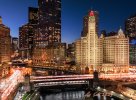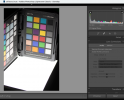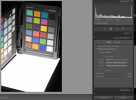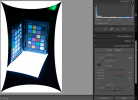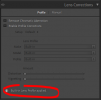The title doesn't explain it all. I'm mostly a still shooter. and 99.9% of the time I shoot raw. For rather Raw+ JPG - but normally toss the JPGs and only use the raw.
But I'm working on a technique to get streaming light trails from cars or any moving lights, doing multiple exposures and blending a bunch of files all shot at 0.8/sec (1.25sec in camera) with 1 master frame.
You use timed exposures- JPGs - 2 sec interval and 1 single image for the overall and load a bunch of them into 1 Photoshop file as layers, change the Blending mode to Lighten to highlight the light trails, hide with a mask, then use 1 single exposure as a master for the scene and paint in the light trails on the mask. You get this: And its pretty cool.
But I found an interesting glitch. I wanted to use the DNG for the master overall image. But when you turn off the Lighten mode layer to reveal the DNG layer, the two images don't match up- even after Aligning all the layers.
The DNG layer has a slightly different shape. I've been beating my head on this for a couple of days because I couldn't get alignment of all my layers, and just now figured out that the DNGs out of camera are 5272 x 3948 pixels and the JPGs - even on the same image - are 5280 x 3956 pixels. WTF...????
For the image I included here I ended up using JPGs for all layers and it looks great. But I really wanted the flexibility of the RAW file for the overall scene.
Anyone have thoughts or ideas on this. Also occurs to me that if I change the output res not he raw file to match the long side, it may then match up. I will try this now.
But I'm working on a technique to get streaming light trails from cars or any moving lights, doing multiple exposures and blending a bunch of files all shot at 0.8/sec (1.25sec in camera) with 1 master frame.
You use timed exposures- JPGs - 2 sec interval and 1 single image for the overall and load a bunch of them into 1 Photoshop file as layers, change the Blending mode to Lighten to highlight the light trails, hide with a mask, then use 1 single exposure as a master for the scene and paint in the light trails on the mask. You get this: And its pretty cool.
But I found an interesting glitch. I wanted to use the DNG for the master overall image. But when you turn off the Lighten mode layer to reveal the DNG layer, the two images don't match up- even after Aligning all the layers.
The DNG layer has a slightly different shape. I've been beating my head on this for a couple of days because I couldn't get alignment of all my layers, and just now figured out that the DNGs out of camera are 5272 x 3948 pixels and the JPGs - even on the same image - are 5280 x 3956 pixels. WTF...????
For the image I included here I ended up using JPGs for all layers and it looks great. But I really wanted the flexibility of the RAW file for the overall scene.
Anyone have thoughts or ideas on this. Also occurs to me that if I change the output res not he raw file to match the long side, it may then match up. I will try this now.




